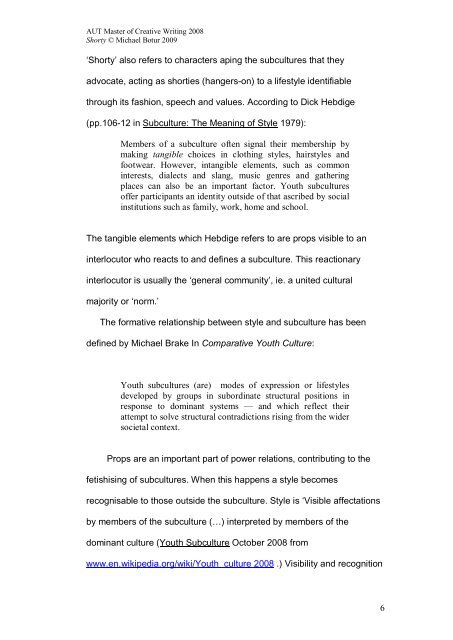AUT Master of Creative Writing Thesis Exegesis - Scholarly ...
AUT Master of Creative Writing Thesis Exegesis - Scholarly ...
AUT Master of Creative Writing Thesis Exegesis - Scholarly ...
Create successful ePaper yourself
Turn your PDF publications into a flip-book with our unique Google optimized e-Paper software.
<strong>AUT</strong> <strong>Master</strong> <strong>of</strong> <strong>Creative</strong> <strong>Writing</strong> 2008<br />
Shorty © Michael Botur 2009<br />
‘Shorty’ also refers to characters aping the subcultures that they<br />
advocate, acting as shorties (hangers-on) to a lifestyle identifiable<br />
through its fashion, speech and values. According to Dick Hebdige<br />
(pp.106-12 in Subculture: The Meaning <strong>of</strong> Style 1979):<br />
Members <strong>of</strong> a subculture <strong>of</strong>ten signal their membership by<br />
making tangible choices in clothing styles, hairstyles and<br />
footwear. However, intangible elements, such as common<br />
interests, dialects and slang, music genres and gathering<br />
places can also be an important factor. Youth subcultures<br />
<strong>of</strong>fer participants an identity outside <strong>of</strong> that ascribed by social<br />
institutions such as family, work, home and school.<br />
The tangible elements which Hebdige refers to are props visible to an<br />
interlocutor who reacts to and defines a subculture. This reactionary<br />
interlocutor is usually the ‘general community’, ie. a united cultural<br />
majority or ‘norm.’<br />
The formative relationship between style and subculture has been<br />
defined by Michael Brake In Comparative Youth Culture:<br />
Youth subcultures (are) modes <strong>of</strong> expression or lifestyles<br />
developed by groups in subordinate structural positions in<br />
response to dominant systems — and which reflect their<br />
attempt to solve structural contradictions rising from the wider<br />
societal context.<br />
Props are an important part <strong>of</strong> power relations, contributing to the<br />
fetishising <strong>of</strong> subcultures. When this happens a style becomes<br />
recognisable to those outside the subculture. Style is ‘Visible affectations<br />
by members <strong>of</strong> the subculture (…) interpreted by members <strong>of</strong> the<br />
dominant culture (Youth Subculture October 2008 from<br />
www.en.wikipedia.org/wiki/Youth_culture 2008 .) Visibility and recognition<br />
6
















